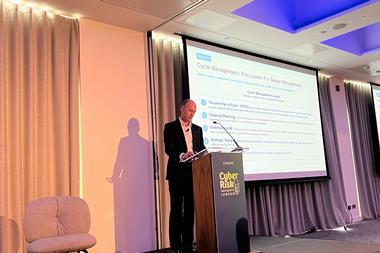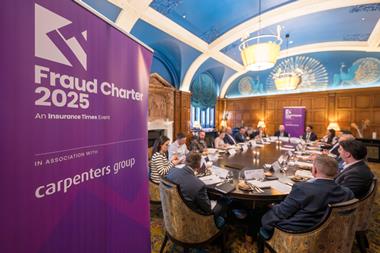November is the cruellest month for some insurers, as fireworks and bonfires fuel their fears over the yearly rise in commercial fire damage. Little wonder when last year fires cost £3.4m per day in the UK. We look at why people commit arson and how insurers can raise the detection rate
November has arrived and the country is once again gearing up for Guy Fawkes Night. But as bonfires are lit nationwide and fireworks decorate the skies, many in the insurance industry are loath to celebrate any festivity featuring flames. Because, as the fallout of the recession continues to burn holes in the economy, the escalating cost of fires is kindling fears about the spread of arson.
According to the ABI, commercial fire damage claims have increased by nearly 20% over the past two years, rising from £365m in the first half of 2007 to £424m during the first half of 2009. Last year, the total cost of fire damage reached £1.3bn: £3.4m for every day of the year.
Meanwhile, AXA’s business crime index this year showed that arson in the commercial sector increased by 23% in the second half of 2008. It is widely predicted that these figures will have climbed further by the time this year draws to a close.
More worryingly, Aviva’s property risk manager Allister Smith believes that 40% of all commercial fires are now arson related.
“I think property insurers are very concerned about it. We have seen a 16% increase in the cost of fire losses and our own losses are fairly reflective of those figures as well. Just under half of all fire losses in the commercial arena are from arson, so it is a serious problem in this country that needs to be tackled,” he says.
“The downturn does have an impact, there is no doubt about that,” Smith adds. “We have seen in previous recessions that you do see a spike in arson claims.”
Feel the burn
There are two main types of arson – fraudulent and malicious – and recession tends to fuel both. As businesses come under increasing pressure to balance the books in times of hardship, the temptation to get rid of a burdensome enterprise while pocketing a handsome insurance payout grows.
“You expect the SME sector to be affected more than the large corporates because there is more ownership at that lower end,” Zurich’s property underwriting manager Larry Stokes explains.
The pressure on companies to cut down on staff also provides other motives. “Businesses that have downsized will be laying off staff and you will find that malicious arson by disgruntled employees will increase.
“I don’t think that any business is immune to arson,” Smith adds.
Furthermore, the number of failing businesses has led to a surge in the number of vacant properties blotting the landscape and proving a magnet for vandals. This has become increasingly noticeable in certain sectors.
“One of the areas you need to look at is the leisure sector, and in particular, pubs, which have one of the highest profiles just now,” AXA’s head of customer risk management Doug Barnett says.
According to the British Beer & Pub Association, more than seven pubs a day are now calling time across Britain.
“If you look at the number of pubs that are closing down, it shows that a lot are struggling. If a pub has gone empty, it will be a target for kids,” Barnett adds.
Abandoned construction sites could also be a locus for such unwanted attention. “We have seen more construction sites that have been mothballed. When they are semi-built, these properties are a bit more vulnerable than when they are completed. The fire security tends to be a bit less because you have got a semi-open building,” Allianz risk control surveyor Andrew Miller explains.
Moreover, the lack of opportunities presented to young people during a downturn can also lead to a rise in anti-social behaviour. “The expectation is that because there is more unemployment and families are under more pressure, children might be tempted to do ‘strange things’,” Stokes says.
Where there’s smoke …
But despite the surge in opportunities and motives for arson, the detection rate remains worrying low. According to Aviva, only 8% of arson cases are detected compared to 24% of all other crimes.
Barnett believes the use of forensic science has become a vital weapon in the industry fight against this crime. “Arson can be very difficult to detect. When we get a large fire, we always put forensics onto it,” he says.
There are some tell-tale signs that may provide clues before that stage, however. Loss adjuster Carmichaels’ managing director, Keith Curling, says that traces of accelerants such as petrol in different areas of the building can be a giveaway.
“Sometimes there can be indicators, such as the repositioning of stock items that are flammable, or you might find a concentration of waste material in a property that wouldn’t normally be there and is obviously been used as another form of accelerant,” he says.
In addition to physical clues, insurers need to be wary of any psychological motives behind a potential arson. Groupama’s head of claims, Phil Bird, says there are a host of signs to be aware of.
“The key type of things to look out for is a business that is struggling to meet its creditor or the tax man. It may be experiencing VAT problems or struggling with its order book. It may be in a trade that is struggling.
“You might find the guy is out of the country when the fire happens and there are no signs of forced entry. Some will range from the obvious to the non-obvious.”
AXA’s index shows that the hotspots for business crime, including arson, are Birmingham, Northampton, Guildford and south-west London. But Barnett warns insurers against the pitfall of exclusively focusing on crime-ridden areas in a bid to spot arson.
“It can really happen anywhere. A lot of people think that where you have major crime is also a place where you get the most arson, but is not necessarily so,” he says. “Quite often, you will have issues in rural areas, for example on farms where outbuildings are being torched. Just because it is a low-crime area doesn’t mean the arson risk is low.”
Firefighting
So what can be done? Smith says insurers need to work more closely with brokers. “They can help educate clients and reduce the arson risk,” he explains.
Smith adds that businesses often need to be made aware of the importance of taking simple precautions, such as placing combustible material away from the building. “Arson is about opportunity,” he says. “Quite often we see a fire that started in a wheelie bin or a skip that has been laid against the business during the day for convenience, when it should be at a safe distance away so that if there is a fire in the skip or bin it doesn’t spread to the actual property.”
Barnett believes more action needs to be taken when insurers are alerted about a building becoming vacant. He says that it is vital to ensure that combustible material is removed from the premises, all keys are accounted for and the building is made as secure as possible.
“I think the big one is to be very proactive when buildings go empty. We’re lucky that we have a large team of surveyors but a lot of insurers don’t have an in-house resource. You have to make sure that if you know a building has gone empty, you get there very quickly,” he says.
All agree that, above all, the public profile of arson needs to be raised in order to tackle the problem. Miller says that ventures similar to drink drive campaigns could be useful in stemming the rising tide of arson costs.
“You have to keep repeating the same old messages, reminding people that fires can destroy your business, they can kill people and it is important that you do take your basic precautions. People always think it is not going to happen to them.”
Bird believes that insurers need to take a tougher approach when it comes to combating arson.
“You have to vigorously investigate and take people to court if necessary,” he says. He adds that insurers need to use detection devices and co-operate more with industry bodies.
“Using fraud tools like Hunter and working with bodies like the Insurance Fraud Bureau is a valuable way to spot trends. I think we need to educate the public that it happens and that it is costing the them money. You can do that through the collective bodies like the ABI.
“If you bring this more to the fore, it means that people who do know that there is something not right may be prepared to talk to insurers and the police.”
It seems that while the blaze of bonfires can be quickly extinguished around this time of year, the threat of arson is set to flare for quite some time.
Case study
Arson comes in many forms and a common scenario is for unsecured wheelie bins to be pushed against premises and then set alight.
Aviva recently dealt with a claim like this at a former mill in the north west. A stolen car was parked alongside the premises of the client – a textile merchant – and deliberately set on fire.
The flames entered the building through the
timber-framed windows and fire took hold inside
the building.
The fire spread quickly owing to the highly combustible nature of the building's contents. The client had done everything possible to make the building secure and to ensure that waste was properly stored.
This was a family-owned business, providing valuable employment in an area suffering some
of the worst effects of the recession. As with
many cases of arson, the perpetrators were never traced. Aviva settled the customer's claim for just under £2m.





































No comments yet